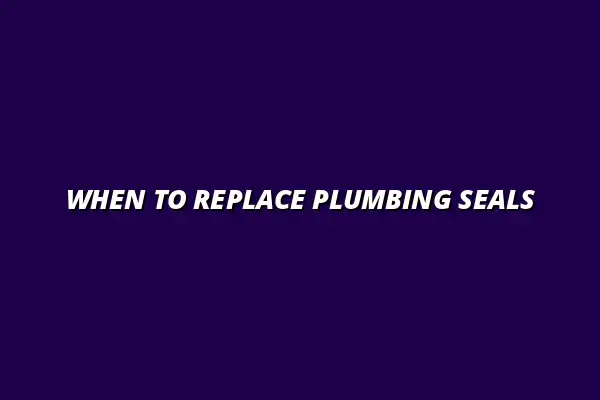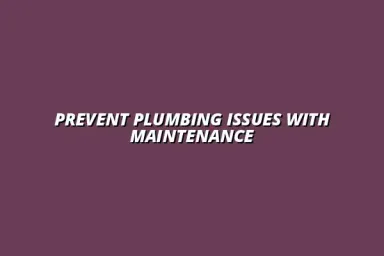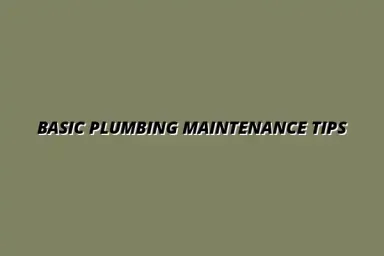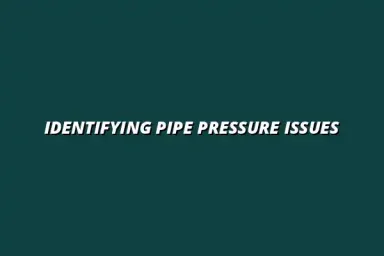Understanding Plumbing Seals and Gaskets
When it comes to plumbing in our homes, a lot of us might overlook the importance of seals and gaskets. These components play a crucial role in ensuring that our plumbing systems function efficiently and without leaks. Understanding these parts can save you from costly repairs and inconveniences down the road!
In basic terms, seals and gaskets are used to create tight connections between different plumbing components. This prevents water from leaking and maintains the pressure needed for your plumbing to work effectively. Let’s dive deeper into what these terms really mean and how they contribute to the plumbing in your home. For example, regularly checking your homeowners plumbing maintenance checklist can help prevent many issues.
The Role of Plumbing Seals and Gaskets in Your Home
Plumbing seals and gaskets are like the unsung heroes of your plumbing system. They help maintain pressure and prevent unwanted leaks. Knowing their definitions can help us appreciate their roles better!
Defining Plumbing Seals
Plumbing seals are specifically designed to fill the gaps between two surfaces. This ensures that water doesn’t escape where it shouldn’t. Common types of seals include thread seal tape and O-rings, both of which can create a tight barrier against leaks.
Overall, seals are essential for keeping connections secure in various plumbing applications, from faucets to pipes. They come in different shapes and sizes, making them versatile for many uses!
Defining Plumbing Gaskets
Unlike seals, plumbing gaskets are usually flat and are placed between two surfaces to provide a *watertight* seal. They are commonly found in flanges and other connections where two parts meet. A gasket ensures that any joint in the plumbing system remains leak-free. Issues with gaskets can sometimes lead to problems like detecting hidden pipe leaks at home, so regular inspection is vital.
Choosing the right gasket is just as important as the seal, as it can significantly affect the longevity and integrity of your plumbing system. So, knowing what a gasket is can help you make more informed decisions during repairs!
Common Materials Used for Seals and Gaskets
Seals and gaskets can be made from several different materials, each with its own set of advantages. The choice of material often depends on the specific application and environmental conditions. Here are some commonly used materials:
- Rubber - Offers durability and resistance to wear.
- Silicone - Known for its flexibility and high-performance capabilities.
- Fiber - Often used in high-pressure systems.
Rubber Seals: Durability and Use Cases
Rubber seals are widely used in plumbing due to their durability. They can withstand various temperatures and pressures, making them suitable for both hot and cold water applications. You can find rubber seals in dishwashers, toilets, and many faucet types!
This material is often favored for its ability to compress and form a tight fit, reducing the risk of leaks. Just keep an eye on them, as extreme temperatures can gradually degrade rubber over time. If you notice issues in your kitchen sink, you may need to consider when to replace kitchen sink plumbing.
Silicone Gaskets: Flexibility and Performance
Silicone gaskets bring an extra layer of flexibility to the table. They can handle high temperatures and resist aging, which is vital for plumbing systems exposed to heat. This makes them ideal for use in kitchen and bathroom fixtures!
Moreover, silicone gaskets can maintain their integrity even under constant pressure, ensuring that your plumbing remains leak-free over time. They are a popular choice for modern plumbing systems looking for reliable performance. Learning how to maintain your bathroom plumbing seals is a key part of preventative maintenance.
Other Material Options: When to Choose Them
While rubber and silicone are popular, there are other materials worth considering. Metal gaskets, for example, are often used in high-pressure environments, while composite materials can provide excellent resistance to chemicals.
Choosing the right material really depends on the specific needs of your plumbing system. By considering factors like pressure, temperature, and the types of fluids involved, you can select the most suitable option for your situation.
Practical Tips for Maintaining Plumbing Seals and Gaskets
Maintaining plumbing seals and gaskets is crucial for preventing leaks and ensuring smooth operation in your plumbing system. Regular care can significantly extend their lifespan and save you money on replacements. Here are some practical tips to keep your seals and gaskets in top shape!
By incorporating simple maintenance routines into your household tasks, you can catch potential issues early and enhance the performance of your plumbing. Follow these guidelines to help your seals and gaskets last longer! For example, preventing clogs in your bathroom sink can be achieved by following these preventative measures.
Regular Maintenance Routines to Extend Lifespan
Establishing a regular maintenance routine for your plumbing seals and gaskets can make a world of difference. Here are some key practices you can implement:
- Routine Cleaning: Use a mild soap and water solution to clean areas around seals and gaskets, removing any grime or buildup.
- Periodic Inspections: Check for signs of wear, such as discoloration or brittleness, at least once every six months.
- Lubrication: Apply a compatible lubricant to moving parts to reduce friction and wear on gaskets.
These steps not only help maintain your plumbing system but also provide you with peace of mind knowing you’re preventing potential issues before they occur. Just a few minutes of your time every few months can save you a lot of hassle down the road!
Cleaning Techniques for Optimal Performance
Cleaning plumbing seals and gaskets is vital for their performance. Here are some effective techniques:
- Gentle Scrubbing: Use a soft brush or cloth to scrub away dirt without damaging the surfaces.
- Rinsing: Rinse thoroughly with water to eliminate any soap residue that could affect performance.
- Drying: Ensure the area is dry before reassembling to prevent trapping moisture, which can lead to mold.
Implementing these cleaning techniques regularly helps maintain a healthy environment for your plumbing seals and gaskets, reducing the chances of damage. If you're experiencing water heater leaks, check out these tips on preventing water heater leaks easily.
Inspection Tips for Homeowners
Regular inspections are essential for spotting issues early. Here are some tips to help you inspect your plumbing seals and gaskets effectively:
- Look for cracks or deformation in seals and gaskets.
- Check for leaks or moisture buildup around joints and connections.
- Inspect for any signs of discoloration, which may indicate wear.
By being proactive and conducting these inspections, you can ensure your plumbing remains in excellent condition and avoid unexpected repairs. For plumbing issues in Billesley, Birmingham, consider contacting a local plumber.
Addressing Common Questions About Plumbing Seals and Gaskets
As a homeowner, you might have questions about plumbing seals and gaskets. Let’s address a couple of the most common ones!
How Do I Know If My Gasket Needs Replacement?
If you're unsure whether your gasket needs replacement, look for these signs:
- Visible Damage: Check for cracks, tears, or noticeable wear.
- Leaking: Water pooling around fittings can indicate a failing gasket.
- Changes in Water Pressure: If you notice fluctuations, your gasket may not be sealing properly.
Being attentive to these signs can help you catch issues early and prevent more significant problems down the line!
Can I Use Any Sealant for Plumbing Applications?
Choosing the right sealant for plumbing is crucial. Here are some guidelines:
- Compatibility: Ensure the sealant is compatible with the materials in your plumbing system.
- Water Resistance: Select sealants specifically designed for water exposure to avoid breakdown.
- Temperature Tolerance: Consider the temperature range in which the sealant operates effectively.
Using the right sealant is vital for maintaining the integrity of your plumbing seals and gaskets!
Summarizing Key Points on Plumbing Seal and Gasket Replacement
In conclusion, timely replacement of plumbing seals and gaskets is essential for maintaining a functional plumbing system. By keeping an eye out for signs of wear and being proactive about maintenance, you can avoid costly repairs in the future.
Remember, a little attention goes a long way! Regular inspections, proper cleaning, and using the right materials can keep your plumbing running smoothly.
Final Thoughts on Importance of Timely Replacement
Replacing plumbing seals and gaskets when necessary is key to preventing leaks and maintaining home comfort. Don’t wait for a small problem to turn into a big issue—be vigilant and proactive!
Encouraging Proactive Maintenance for Plumbing Systems
By adopting a proactive approach to maintenance, you can ensure your plumbing remains in great shape. Regular checks, cleaning, and timely replacements will help you avoid unexpected issues and save you from stress down the line.
Take charge of your plumbing care today for a worry-free tomorrow!

 Kiran Almasi
Kiran Almasi

